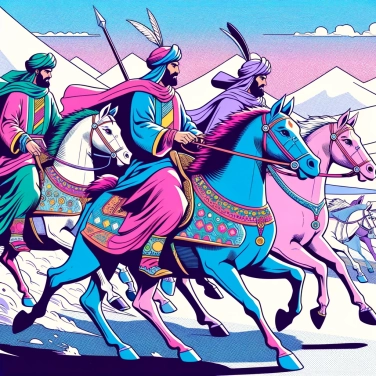In detail, for those interested!
Why did the Persians use horse messengers?
The Persians used horse messengers to establish a fast and efficient communication system throughout their vast empire. This practice was essential to maintain political and military control over such a vast territory. Horse messengers were able to transmit messages over long distances in record time, which was crucial for coordinating military actions, transmitting orders, and strategic information.
The use of horses for communication offered several advantages to the Persians. Horses were fast, resilient, and capable of covering long distances without getting tired. This allowed messengers to travel quickly from one end of the empire to the other, bypassing natural obstacles and avoiding difficult roads. In addition, horses were well suited to carrying written messages or bulky items over long distances, which would have been much more difficult to achieve on foot.
The use of horse messengers was an integral part of the Persian imperial communication network, known as the "Royal Road". This network connected the main cities of the empire, facilitating commercial, diplomatic, and military exchanges. Horse relays were established along the route to allow messengers to change mounts and continue their journey without interruption, ensuring continuous and fast communication.
The efficiency of horse messengers in the Persian empire contributed to strengthening the centralization of power and consolidating the political control of the rulers. Thanks to this fast and reliable communication system, the Persians were able to make informed decisions in real time, react quickly to events, and maintain their authority over a diverse and extensive territory.
By inheriting this tradition of horse communication, the Persians left a lasting impact on history. Their innovative use of horse messengers influenced other civilizations and laid the groundwork for the further development of communication and transportation systems worldwide.
The benefits of horseback communication
Horseback communication offered many advantages for the Persians. First of all, it allowed for fast and efficient transmission of crucial information. Horse messengers were able to cover long distances in a short amount of time, ensuring quick communication between different regions of the Persian empire.
Furthermore, the use of horse messengers provided greater security compared to other means of communication. Horses were fast and agile, allowing messengers to bypass obstacles and potential dangers on their way. This reduced the risk of messages being intercepted by enemies or bandits.
Additionally, horseback communication allowed the Persians to maintain closer control over the information circulating within their empire. Horse messengers were often well-trained soldiers, capable of protecting the messages they carried. This ensured the confidentiality and accuracy of the information transmitted.
Lastly, horseback communication offered increased flexibility to the Persians. Thanks to horse messengers, it was possible to quickly adjust military, diplomatic, or administrative plans based on new information received. This reactivity was a major asset for the Persian empire in a context where events could evolve rapidly.
In summary, the advantages of horseback communication for the Persians were numerous: speed, security, control, and flexibility. These qualities made it an essential tool for maintaining the cohesion and effectiveness of the Persian empire.
The Persian imperial messaging network.
The Persian imperial messaging network was a sophisticated communication system used by the Persian Empire to transmit important information across vast territories. This network relied on strategically positioned relay stations along the empire's main commercial and military routes. Horse messengers were tasked with carrying official dispatches, imperial orders, and urgent news from one station to another.
Each relay station was equipped with fresh horses ready to be mounted by messengers in search of speed. The relays were generally about 25 to 30 kilometers apart, allowing messengers to cover long distances in record time. This relay system enabled messages to travel at an impressive speed throughout the entire Persian Empire, which was essential for maintaining centralized control of the empire and ensuring fast communication between different regions.
The Persians established this imperial messaging network around the 6th century BC, under Emperor Cyrus the Great. This logistical innovation played a crucial role in the success and longevity of the Persian Empire, allowing leaders to remain informed in real-time of events unfolding across the empire. The Persian imperial messaging network helped strengthen the cohesion of the empire by facilitating the rapid transmission of information and promoting efficient administration on a large scale.
The effectiveness of horse messengers in the Persian Empire
The efficiency of horse messengers in the Persian Empire relied on several key factors. Firstly, horses were fast and enduring animals, allowing messengers to cover long distances in a relatively short amount of time. Additionally, well-maintained imperial roads facilitated the quick movement of messengers across the empire. These communication routes were monitored and protected, ensuring the safety of messengers and their messages.
The Persians used a relay system along the roads, where messengers could change to fresh horses at regular intervals, guaranteeing a constant speed of message transmission. This efficient organization allowed important news to circulate quickly throughout the empire, whether it be military, political, or economic information.
Furthermore, the Persians had developed a system of encoding and decoding messages, ensuring the confidentiality of the information being transmitted. This security enhanced the effectiveness of the horse messenger network, as sensitive communications could be safely transmitted without the risk of interception.
In summary, the efficiency of horse messengers in the Persian Empire relied on the combination of fast horses, relay organization, road security, and message confidentiality, making this communication system an essential pillar of the Persian administration.
The legacy of horseback communication in history
The Persians left a lasting legacy in the history of horseback communication. Their efficient messaging system influenced many civilizations that followed. For example, the Roman Empire adopted similar practices to quickly transmit information across their vast territory. Similarly, the Mongols perfected horseback messaging techniques to build their empire and expand their influence over a large part of Asia.
The use of horse messengers remained a vital communication method for centuries, even after the disappearance of the empires that popularized it. The postal routes established by the Persians served as a model for other civilizations, facilitating trade, diplomacy, and the dissemination of knowledge.
Today, the legacy of horseback communication continues symbolically through practices such as equestrian relays and horse races. This tradition recalls the historical importance of horse messengers and their role in the development of communication systems worldwide.
![Explain why some countries change time zones?]()
![Explain why Alexander the Great refused to wear shoes.]()
![Explain why Alexander the Great always wore an impressive helmet.]()
![Explain why the last Chinese emperor was so young when he came to power?]()




















